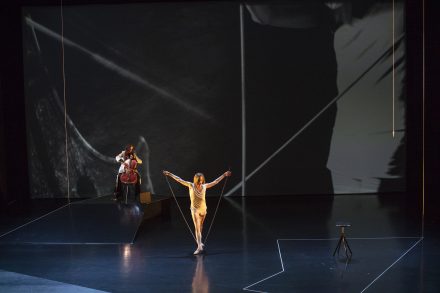THE DAY
Wendy Whelan + Maya Beiser + Lucinda Childs + David Lang
Doris Duke Studio
Jacob’s Pillow Dance Festival
Becket, Mass.
Friday, August 2, 2019
Review by Seth Rogovoy
(BECKET, Mass.) – THE DAY is often discussed in context with the events of 9/11 (September 11, 2001). While there may be certain elements of the multimedia performance that comment on, draw from, or respond to the horrors of that day, imposing such a framework diminishes the significance of this stunning masterpiece, a collective collaboration among four of the world’s leading visionary artists as well as a cutting-edge crew of designers. In the course of seeing the piece last Friday night, one or two moments may have put me in mind of 9/11. But what art created since then doesn’t, in the same manner that all creative work made since 1945 cannot help but be contextualized as part of life in the post-WWII world?
THE DAY is about so much more – or is it less? — than 9/11, and most of what it is about is what it is. It is at first the austere, haunted, gorgeous music by Pulitzer Prize-winning composer and Bang on a Can cofounder David Lang. It is the music brought to life by Lang’s muse, avant-garde cellist Maya Beiser, for whom Lang composed the two pieces – the day and world to come – that comprise the work. It is then “about” Wendy Whelan, the former principal dancer with the New York City Ballet gone somewhat rogue over the better part of the last decade by working with modern dance and avant-garde choreographers such as Lucinda Childs, whose postmodern, minimalist style is picture-perfect for Whelan and THE DAY.
Or as Beiser herself writes in a program note, “THE DAY is a response to two solo cello works written for me by composer David Lang.” Emphasis on the ultimate period.
Whelan transcends “dance.” From the moment the lights went up on the stage and she was seen half-sitting on a stool, legs splayed out at seemingly impossible angles, one was thunderstruck by the absolute control she exerted over every muscle and sinew in her body, each one present and accounted for, even when at rest. Whether she was walking, running, standing still, spinning around, or moving in a more “dancerly” fashion, Whelan was an astounding sight to behold.
In addition to Beiser’s cello, the first half of the performance, the day, featured text that Lang crowd-sourced over the Internet. Every six seconds Beiser’s pre-recorded voice read another response to Lang’s original prompt, which was “I remember the day …” The answers ranged from “I fell in love” to “I disrespected my mom” to “I realized I was no longer depressed.” The words wrapped around Beiser’s weeping, haunting cello, and the white-bedecked Whelan danced together with those sounds – apparently largely by improvisation – with various white props and against a black-and-white video projection.
For the second half of the performance, world to come (and yes, the title has the same initials as World Trade Center), Beiser and Whelan traded white for black and traded places onstage – Beiser moving downstage to stage left from her upstage stage right perch in the first half. With no text here, Whelan’s movements were more conventionally dance-like, drawing on both ballet and modern dance vocabularies while remaining appropriately minimalist, as determined by Childs and the music itself.
Playing the entire hourlong score from memory, Beiser had even heavier lifting in world to come, having to interact and “dance” with her own prerecorded cello loops. With no score to follow, she could only know from feel or intuitive memory where and when those loops were going to take off and land; it was thrilling to watch her handling this challenge, a case of astonishing virtuosity being stretched to superhuman limits – all of which can be said equally of Whelan’s corresponding movement.
In this arena constructed by Lang, Childs, scenic designer Sara Brown, costume designer Karen Young, lighting designer Natasha Katz, sound designer Dave Cook, and projection designer Joshua Higgason, Maya and Wendy played so well together. And in the end, that’s what it’s all about.
Seth Rogovoy has been writing about the Berkshire cultural scene for over three decades.

